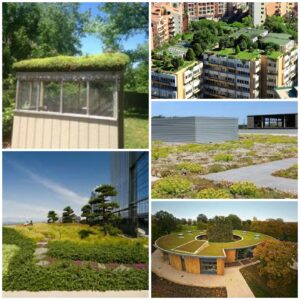
Green Roofs
A green roof, or living roof is a roof is partially or completely covered with a growing medium and vegetation, planted over a waterproof membrane. Green roofs can be large scale on public or commercial buildings, or can be utilized on residential houses, sheds, or porches. At The Plant Professionals, we have a green roof on our Grow Pot Exchange, added in 2014.
Roof gardens were initially developed by the ancient civilizations of the Tigris and Euphrates river valleys. The most famous is the Hanging Gardens of Babylon. Today, planting on roofs and walls is one of the most innovative and rapidly-growing areas in the fields of ecology, horticulture, and construction development.
In European countries, the technologies and use of green roofs and walls are much more advanced, in part as a result of government legislation and financial support. Here in North America, we are seeing a growth in this industry. Many cities have now passed building codes, offering incentives to developers who put green roofs on their buildings.
Green roofs can be installed on many existing buildings as well as new developments. An engineer will determine if an existing structure can support the additional loads.
Vegetated roofs have many advantages. According to a study by Penn State University, a green roof can extend the lifespan of a roof by over 200%. The waterproofing membrane, growing medium, and vegetation shield the roof membrane from ultraviolet radiation and physical damage. Green roofs also provide significant sound insulation, and prolong the service life, while reducing the energy use of heating, ventilation, and HVAC systems through decreased use.
A living roof reduces rainwater runoff by absorbing 70-90% of the precipitation that falls in summer and 25-40% in winter. The water that is not absorbed gets filtered through the vegetation and growing medium.
In urban areas, green roofs reduce the distribution of dust, particulate matter, and the production of smog. Vegetation can filter out fine airborne particles as the air passes over and through the plants, settling on the leaf and stem surfaces. This material will be washed into the soil by rain. The foliage can also absorb gaseous pollutants into their tissues.
High concentrations of buildings and paved areas lead to heat islands in cities. With the use of green roofs, the light is absorbed by the vegetation, reducing energy that would otherwise be turned into heat.
A living roof creates habitat for wildlife and decreases the stress of the people who work and live around the space by providing a more aesthetically-pleasing landscape. Some homes, commercial and hospitality businesses such as hotels and restaurants, find their most sought-after spaces are on the roof.Click on the link below if you are interested in learning more about green roofs: https://greenroofs.org/about-green-roofs/
Roof gardens were initially developed by the ancient civilizations of the Tigris and Euphrates river valleys. The most famous is the Hanging Gardens of Babylon. Today, planting on roofs and walls is one of the most innovative and rapidly-growing areas in the fields of ecology, horticulture, and construction development.
In European countries, the technologies and use of green roofs and walls are much more advanced, in part as a result of government legislation and financial support. Here in North America, we are seeing a growth in this industry. Many cities have now passed building codes, offering incentives to developers who put green roofs on their buildings.
Green roofs can be installed on many existing buildings as well as new developments. An engineer will determine if an existing structure can support the additional loads.
Vegetated roofs have many advantages. According to a study by Penn State University, a green roof can extend the lifespan of a roof by over 200%. The waterproofing membrane, growing medium, and vegetation shield the roof membrane from ultraviolet radiation and physical damage. Green roofs also provide significant sound insulation, and prolong the service life, while reducing the energy use of heating, ventilation, and HVAC systems through decreased use.
A living roof reduces rainwater runoff by absorbing 70-90% of the precipitation that falls in summer and 25-40% in winter. The water that is not absorbed gets filtered through the vegetation and growing medium.
In urban areas, green roofs reduce the distribution of dust, particulate matter, and the production of smog. Vegetation can filter out fine airborne particles as the air passes over and through the plants, settling on the leaf and stem surfaces. This material will be washed into the soil by rain. The foliage can also absorb gaseous pollutants into their tissues.
High concentrations of buildings and paved areas lead to heat islands in cities. With the use of green roofs, the light is absorbed by the vegetation, reducing energy that would otherwise be turned into heat.
A living roof creates habitat for wildlife and decreases the stress of the people who work and live around the space by providing a more aesthetically-pleasing landscape. Some homes, commercial and hospitality businesses such as hotels and restaurants, find their most sought-after spaces are on the roof.Click on the link below if you are interested in learning more about green roofs: https://greenroofs.org/about-green-roofs/

